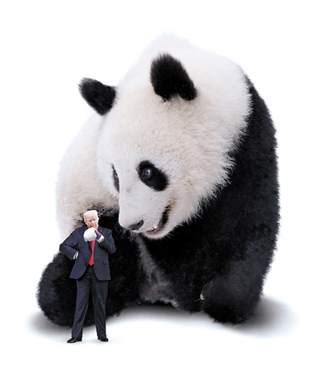A new Thucydides Trap

The author is an editorial writer at the JoongAng Ilbo.
The prolonged trade tensions between the United States and China pose the latest case of the Thucydides Trap — the idea that when one great power threatens to displace another, war is almost inevitable. As the weekend trade talks broke off without a deal, a new battle has begun in the global commerce landscape, with the United States triggering its fourth set of tariff firearms. Washington has much stronger firepower than China. The United States has upped tariffs to 25 percent on a total of $575 billion Chinese imports so far. During the same period, China’s counterattack on U.S. imports stopped at $155 billion. The battleground looks to be in favor of the United States, but the results are yet unknown. Washington’s ever-aggressive moves suggest Beijing does not humble easily.
The United States has overcome the deadly trap — which was first identified by the ancient Greek historian Thucydides to explain the rise of Athens and the fear it inspired in Sparta, which lead to war — four times so far. It has won every war. The first was in the 18th century, when it gained independence from Britain. The second was its war against Germany during World War II, and the third was against the Soviet Union during the Cold War. Three events led to global wars or tensions. Economic predominance had been at the heart of each of the conflicts. The fourth was against Japan over economic hegemony following World War II. It subdued Japan through the Plaza Accord when the Japanese yen was forced to appreciate against the U.S. dollar.
The countries that took on the United States all suffered. Britain, which enjoyed a heyday with “the sun never setting on the British empire,” today ranks fifth in gross domestic product (GDP) and its outlook is murky due to Brexit. Germany maintains the fourth-largest economy in the world backed by its technological prowess, but its economy is expected to generate a marginal growth of 0.8 percent this year. Russia has been struggling due to U.S.-led economic sanctions. Despite its size, its economy has been pushed back by South Korea to rank 12th last year.

China is the next contestant the United States faces in the hegemonic battle. The future of global economy hinges on the consequence. A full-blown war is avoidable because both countries have nuclear arms. A trade war is the only option to define their supremacy. Last March, U.S. President Donald Trump signed an executive order directing the Commerce Department to trim its near $400 billion trade deficit with China. The two states entered a cease-fire in December after China launched a counter-tariff attack. Economic envoys have been traveling back and forth throughout the year, but have failed to come to a compromise.
The Nihon Keizai Shimbun, a Japanese newspaper, reported that the latest talks broke down because China’s President Xi Jinping and other hard-line members of the Communist Party struck down the concession outline packaged up by Vice Premier Liu He. Tensions were heightened after Trump issued self-congratulatory tweets about China being “beaten so badly” and warning China to “act now” if it does not want to be further burnt. An additional $300 billion worth of imports from China could face hiked tariffs, which means that practically all Chinese shipments face punitive duties. UBS Securities estimated that the Chinese economy’s growth would suffer a maximum 2-percentage point decline as a result.
The trade war is expected to be a lengthy one as Xi shows no intention of relenting. An easy win was expected at the beginning. The United States is unrivalled in military and economic prowess. It also has all the traditionally-rich countries behind it — Japan and peers in Europe. China has begun to wobble after years of staggering debt-financed growth. Some in China have been warning of a bubble burst from the rapid transition.
Yet the contest has been panning out differently. Time appears to be on China’s side. As China grows by 5 percent annually, its economy will get bigger than that of the United States by 2030. The trend won’t change regardless of the heavy tariffs. As long as Beijing manages to avert a major financial crisis or a slowdown, China is set to become stronger. During his recent visit to Seoul, Chi Fulin, president of the China Reform Institute, was confident of China’s eventual win. He admitted to short-term headwinds from a slowed global economy. But in the longer run, China has “nearly infinite potential.” In spite of setbacks on the trade front, China’s economy grew by 6.4 percent in the first quarter. Moreover, the country has made fast headway in the fourth industrial revolution.
China already closely chases the United States in big data, artificial intelligence (AI), autonomous vehicles and e-commerce. China is expected to outrank the United States in AI research with a surge in academic research on key technologies, according to Allen Institute for Artificial Intelligence. In its AI strategy, the United States mentions the threats from China. Chinese enterprises pose as formidable rivals to U.S. technology multinationals. Baidu, Alibaba and Tencent have all joined the world’s top 10 market-cap stocks along with Google, Apple, Facebook, Amazon and Netflix.
The United States has gone all-out to rein in the influence of wireless equipment maker Huawei Technologies. It even arrested its CFO Meng Wanzhou, daughter of the founder and CEO of Huawei, and led a boycott campaign. Yet its Western allies — including Germany and Britain — all refused to comply. Italy irked Washington by joining China’s ambitious One Belt One Road initiative.
That’s not all. China is backed by a strong army of “unicorns.” The number of unicorns — start-ups valued over $1 billion — China has is 92: the United States only has 156.
As in the GDP, China has become 60 percent as big as the United States in future growth given the unicorn population. Korea has just six unicorns.
China has almost completed building its semiconductor fortress. It plans to replace 75 percent of imported chips — mostly Korean made — with local products by 2025. By then, China won’t be able to hide its prowess.
The United States has defeated Britain, Germany, Russia and Japan through military or economic wars over the last two centuries. Whether it can triumph over China remains uncertain. It is hard for China to become a single superpower like the United States even when its GDP becomes the world’s largest. But it will become big enough to shape the global order through its infrastructure, funding, and economic partnership networks such as the Asian Infrastructure Investment Bank (AIIB) and the Regional Comprehensive Economic Partnership (RCEP).
Trump has made enemies with traditional allies with his America First campaign. As a result, more countries have turned to China. Over 150 government envoys turned up in the summit forum on One Belt One Road initiative in Beijing last month.
A strong China poses both an opportunity for and a threat to Korea. Because of its reliance on the Chinese economy, Korea could also benefit from its expansion. Still, China is less willing to share its market to Korean capital.
China has taken up Korean products in most categories of the manufacturing sector. Hyundai Motor has been struggling in the Chinese market and Samsung Electronics cannot even command 1 percent in the smartphone market.
Korea must build its own resilience and competitiveness. It must strengthen bio and AI sectors, and widen the gap in semiconductor technology so that the country can survive in the face of U.S. protectionism and China’s rising technologies.
JoongAng Ilbo, May 13, Page 26










with the Korea JoongAng Daily
To write comments, please log in to one of the accounts.
Standards Board Policy (0/250자)